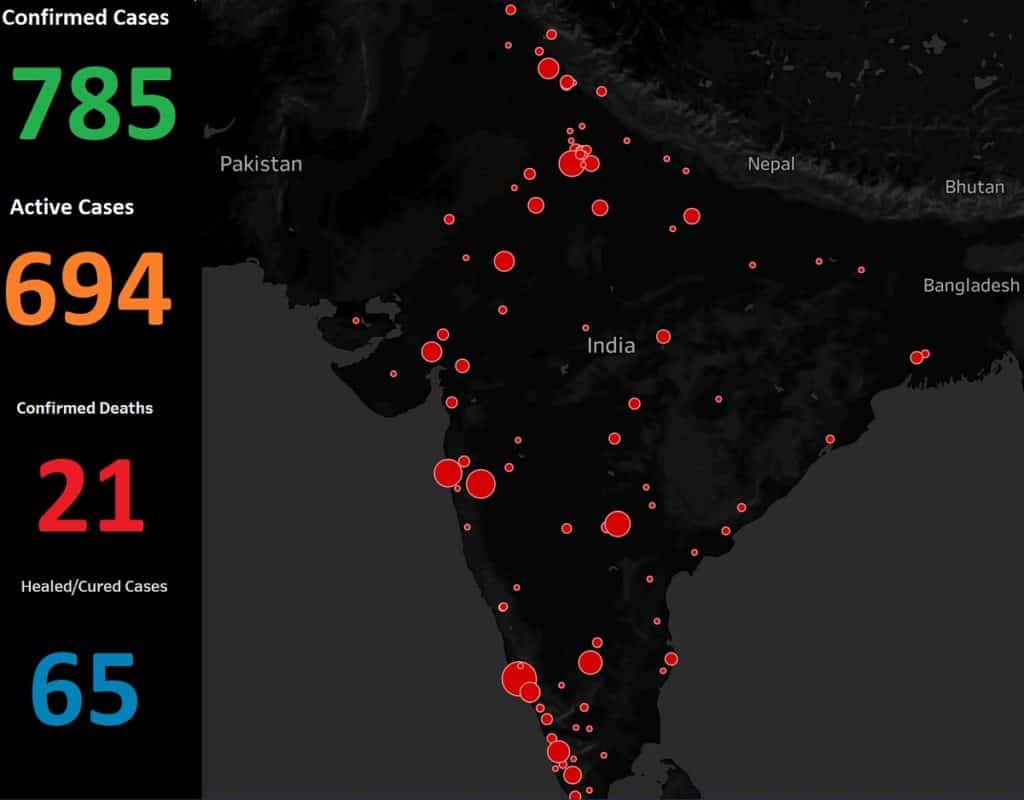Despite, Prime Minister Modi’s extreme action, India under lockdown, fear against the coronavirus pandemic rises. The second most populated country in the world hasn’t experienced the major wrath of the perilous virus. Current cases stand as 785 infected, 694 active cases, 21 deaths and more than 70 recovered. Simultaneously creating an underlying fear that the country is susceptible to a larger and even worse damaging attack. In such a case, is India ready to face the contagion Coronavirus?
Status of Coronavirus Epidemic in India
As of today, India has officially reported over 677 cases, with 17 deaths. On the other hand, only up to 67 positive individuals are cured and discharged. Subsequently, according to current figures Maharashtra is the worst hit with about 147 cases so far. Similarly, the cases in Kerala stood at 138. Meanwhile, Karnataka and Telangana seem to have comparably lesser coronavirus cases that are 62 and 45 respectively. Further on, Tamil Nadu has seen a surge with the addition of 6 new cases it has 35 live COVID-19 patients. Likewise, Delhi, Uttar Pradesh, and Gujarat have 39, 46, and 44 coronavirus cases. While West Bengal, Madhya Pradesh, and Andhra Pradesh have 10, 24 and 12 positive individuals respectively. Also, it has been spreading in Jammu and Kashmir (13), Ladakh (13), and one coronavirus case in Mizoram, and Manipur.

Is it Necessary to Panic? Concerning the Testing Rate Yes!
Considering the reported rate of infection, India is handling the issue with the utmost care, urgency and transparency. However, the underlying question -Is the data presented forth accurate? Or is the data a result of less testing. For instance, South Korea has only 3.8% of India’s population, yet has over 9000 Coronavirus cases, because they carry out 15,000 tests everyday. Similarly, in the UK, 5% of India’s population carry out 60,000 to 70,000 tests per week and plan on increasing it. With this regard, one may wonder whether the 14,175 tests till date is sufficient enough.
Despite, WHO emphasizing the need to check and conduct tests why isn’t India following the order. Is it because India lacks resources and will not be able to handle the patients? Or is India buying time to procure sufficient testing kits, isolation rooms, and hospital beds?
Major Challenge that India will Face, if and When the Epidemic Increases
The uneven health care facilities across the nation will have a huge impact on the citizens as well as contribute to the extension of the pandemic spectrum. Further, the hospitals will be overwhelmed with the abundant admission and thus, shall not provide the best care. Also, the sudden surge will deplete the basic requirements such as masks, gowns, drugs, beds, and ventilators.
Besides, the Indian medical facility has not advanced to the 21st century, so the gap will pose a major threat. Additionally, it is impossible to mass quarantine and hospitalize in every coronavirus case. Additionally, one of the most important reasons is that India spends only 3.66% of its GDP on healthcare, rather than 10% which will prove troublesome in the present scenario.
WHO’s Swaminathan Agreeing to the Indian Healthcare Plight
Recently, Swaminathan stated that the Indian health care management system is highly variable. Furthermore, he added that few states have high tech exceptional facilities while others have low-grade minimal facilities. Additionally, he advises that the government must address the issue and plan short, medium, and long-term solutions for the same.
Few States to Run out of Hospital Beds!
An alarming revelation suggests that India will have no beds if the cases start to rise. Also, this depicts that only critical patients will be hospitalized while the rest will not have the option. Thereby, increasing the chances of infection. Highlight, that Kerala, Maharashtra, Delhi, and Punjab are among the states that will face the situation. Accordingly, the status will be dependant on three factors- the number of beds available, the incidence of thecoronavirus cases, and the elderly population. However, the various factors such as releases, the rate of spreading, deaths, cure, and so on will play a prominent role in this theory.
Few other Reasons which Suggests that India will Struggle to Handle the Outbreak
One of the major ways to prevent spreading is regular cleaning and washing of hands. However, over 29.4% of Indian slums don not have clean water facilities. Further, with the spike in sanitizer cost, they certainly cannot afford it. Following that, another preventive act in isolation or social distancing. This is quite difficult when an average of 445 individuals live in 1 square kilometer. In certain cases, reaching the crowd is even more difficult. For instance, in a country with a mixed population, it is hard to spread the information across all the urban, rural, and slum residents. Additionally, the plight of the daily wagers is uncertain following the lockdown, which poses a severe problem in the coming days.
Conclusion
India has a record of beating a few of the deadly epidemics like polio, swine flu, Nipah virus, H1N1, and so on. Also, it has an influenza surveillance program to avoid viral outbreaks. Accordingly, we have to strategize and beat the coronavirus COVID-19. In this case, few of the chief responsibilities of the government are to maintain transparency by providing a clear picture of the situation. Also, this involves communicating openly regarding the situation with the remedial measures that must follow.